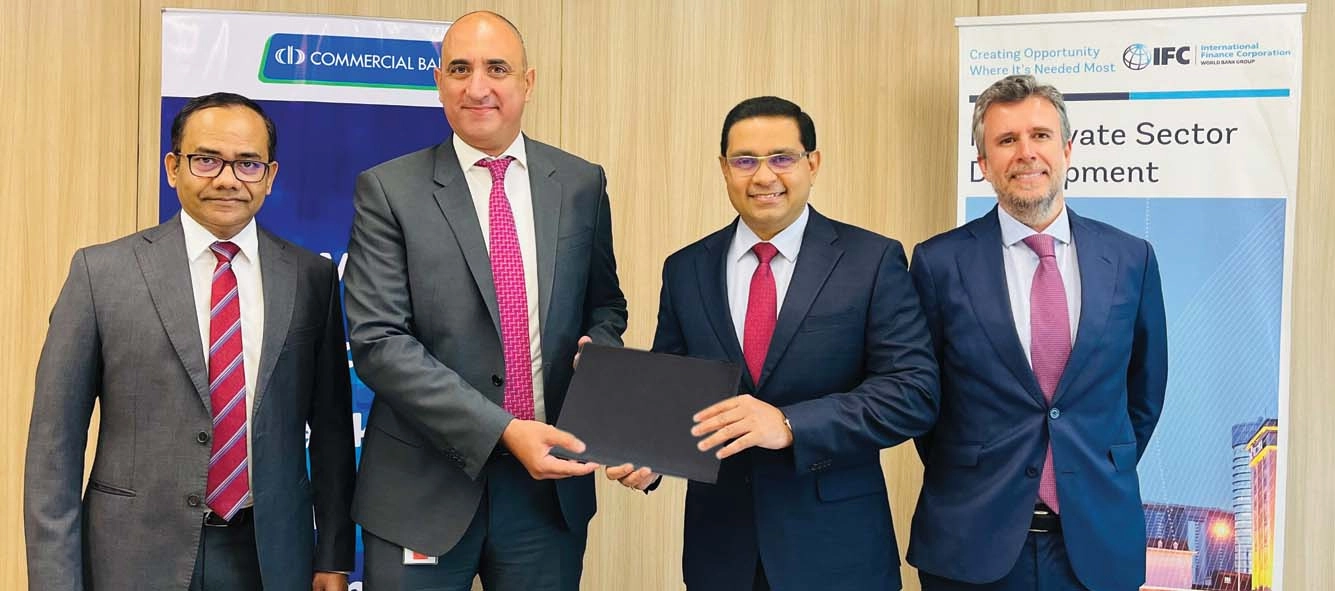My Report


Integrated Report

Integrated strategy for long-term value creation
Managing Director/Chief Executive Officer's and Chief Financial Officer's Statement of Responsibility
Independent Assurance Report - Internal Control
At Commercial Bank of Ceylon PLC, our strategy is not just a roadmap for growth; it is a dynamic framework that embodies our purpose, vision and values, driving long-term value creation for all stakeholders. The Bank’s Strategic Framework integrates financial imperatives with ESG priorities to ensure sustainable progress across multiple dimensions. Our strategy is underpinned by a deep understanding of the evolving external environment, stakeholder needs and regulatory requirements. This enables us to strike a balance between growth, resilience and sustainability, ensuring that our business remains future-ready in a constantly changing world.
Our purpose, vision, mission and values (refer inner front cover) define who we are and what we aspire to achieve, serving as the foundation upon which our strategy is built.
Alignment with stakeholder expectations and long-term sustainability goals
Our strategy is intricately aligned with stakeholder expectations and long-term sustainability objectives. By integrating ESG factors into our Business Model, we ensure that our actions contribute meaningfully to the SDGs while delivering consistent value to shareholders, customers, employees and the wider community. By embedding ESG considerations into our strategic decision-making, we ensure alignment with global best practices, contributing to broader societal goals while securing long-term economic viability. This comprehensive approach allows us to remain a trusted financial partner, fostering innovation and driving positive societal change.
Strategic planning process
The Bank’s strategic planning process is a cornerstone of its sustained success and industry leadership, ensuring that strategic priorities remain dynamic and responsive to evolving stakeholder expectations and market conditions. At any given time, the Bank operates under a 5-year Strategic Plan, which is prepared, reviewed and updated annually on a rolling basis by the Management, with guidance and oversight from the Board of Directors. This well-honed process, developed over several decades, has played a pivotal role in steering the Bank towards prudent growth, customer centricity, innovation and operational excellence, enabling it to achieve the leadership position it enjoys today. The current Strategic Plan 2025–2029, approved by the Board in December 2024, outlines ambitious yet measurable targets across all areas of strategic priority, ensuring sustained value creation and long-term sustainability. This process is further guided by a Board-approved Planning Policy, providing a structured framework for its effective development and implementation.
The robustness of this process is clearly demonstrated by the Bank’s achievement of its status as the largest and most trusted private sector bank in the country.
Sustainability is not a separate component of our strategy but is woven into the fabric of our strategic framework. Our strategic imperatives directly address pressing societal challenges such as financial inclusion, climate action and digital empowerment, ensuring that we contribute meaningfully to sustainable development. This holistic integration of sustainability into our strategy strengthens our ability to deliver long-term value while remaining aligned with global sustainability goals.
Efficient execution is as critical as strategic planning itself. To this end, the Bank has embedded a structured monitoring and reporting mechanism into its strategic planning framework. Progress is reported to the Management on a monthly basis and to the Board on a quarterly basis, with a joint mid-year review conducted by the Management and the Board. This disciplined approach enables the Bank to continuously track progress, respond proactively to emerging risks and opportunities and make timely adjustments to reflect changes in the external environment, thereby maintaining its competitive edge.
Purpose-led strategic imperatives
Our strategic priorities reflect our commitment to achieving sustainable growth, customer satisfaction, operational excellence and innovation. These priorities are categorised under five core imperatives, each designed not only to drive financial performance but also to deliver shared value to stakeholders in line with the Bank’s purpose, across the short, medium and long term (please refer pages 81 and 82).
Resource allocation
The Bank has adopted a disciplined and strategic resource allocation approach to ensure that investments are directed towards initiatives that maximise stakeholder value, while remaining aligned with our core purpose and long-term strategic priorities. The Board provides oversight not only on resource allocation decisions but also on trade-offs involving the balancing of competing priorities, ensuring that the Bank remains agile and responsive to both risks and opportunities.
Resource allocation at the Bank is not just about financial investment; it reflects our strategic intent to deliver sustainable value. We carefully balance resource allocation across capitals - financial, manufactured, human, intellectual, social & relationship and natural - to drive growth and resilience. This approach ensures that every investment we make supports both immediate goals and long-term ambitions.
Our approach to resource allocation is guided by four key principles:
Strategic alignment
Every resource allocation decision is evaluated in the context of its alignment with the Bank’s strategic priorities. Whether it is capital investment, technology deployment or talent acquisition, we ensure that resources are directed towards strategic priorities.
Efficiency and productivity
Given the capital-intensive nature of banking, optimising resource utilisation is crucial. By enhancing operational efficiencies, leveraging digital transformation and adopting process improvements, we maximise productivity while minimising wastage.
Risk-adjusted returns
The allocation of financial resources, capital in particular, is carefully balanced to achieve optimal risk-adjusted returns. We prioritise products, sectors, customer segments and markets that promise sustainable profitability while maintaining a robust risk management framework.
Sustainability integration
Our commitment to sustainability extends to resource allocation as well. We allocate resources to ESG-aligned initiatives, green financing and projects that promote long-term environmental and social well-being.
Key resource allocation areas
Strategic trade-offs
In a highly dynamic and competitive environment, making strategic trade-offs is essential to achieving balanced outcomes. These trade-offs reflect the Bank’s commitment to integrated thinking, balancing competing priorities such as short-term profitability with long-term sustainability, innovation with risk management and regional expansion with a strong local focus. By carefully navigating these choices, the Bank ensures that it remains resilient, agile and forward-looking in a constantly evolving landscape. The following examples highlight how the Bank manages these strategic choices to ensure sustainable value creation:
1. Short-term profitability vs. long-term sustainability
Investments in sustainable practices, such as green financing and carbon-neutral operations, may not yield immediate financial returns; however, they are indispensable for ensuring long-term resilience, adherence to global sustainability standards and safeguarding the Bank’s social license to operate. Consequently, the Bank strategically channels resources towards ESG initiatives as part of its journey towards Net Zero, even if it impacts short-term profitability, to ensure enduring value and align with international environmental commitments. A notable example is the Bank’s decision to launch green financing products, a move that entailed balancing specific risks inherent to such products over and above the conventional risks associated with other forms of lending, against their long-term environmental benefits and the overall enhancement of stakeholder trust and value creation.
2. Innovation vs. risk management
Pursuing innovative financial products and digital solutions introduces new operational and market risks. Hence, the Bank balances the drive for innovation with robust risk management frameworks to mitigate potential risks associated with new product offerings and technological advancements. A relevant example is the adoption of AI/ML technologies, where Risk Management plays an active role by developing new policies and practices to govern and manage their use, ensuring the Bank capitalises on their benefits while mitigating potential risks. Similarly, advancements such as Cloud technology, Identity Access Management, and Data Analytics in credit underwriting require robust governance frameworks to address associated risks effectively. These examples highlight the Bank’s commitment to fostering innovation while maintaining a steadfast focus on prudent risk management.
3. Global expansion vs. local market focus
Expanding into international markets offers growth opportunities but may divert attention and resources from strengthening domestic market positions. Yet, the Bank strategically allocates resources for regional expansion while ensuring that the domestic franchise remains robust and competitive.
4. Standardisation vs. customisation
Standardising services and processes enhances efficiency but may not meet the unique needs of diverse customer segments. The Bank strikes a balance between standardising operations for efficiency and customising services to cater to specific customer requirements, thereby enhancing customer satisfaction.
ComBank partners with IFC to develop Supply Chain Financing strategy

The Bank collaborated with the International Finance Corporation (IFC) to build a Supply Chain Financing (SCF) strategy that will enable the Bank to lend more to SMEs. IFC has identified the Bank as a strategic banking institution in Sri Lanka to take the position as a leading SCF bank, given its prominent presence in corporate and business banking and its strategically diversified branch network.
5. Employee specialisation vs. multiskilling:
Specialised roles can lead to high expertise in specific areas, while multiskilled employees offer flexibility and adaptability. The Bank invests in employee development programs that balance specialisation with multiskilling to create a versatile and competent workforce capable of adapting to changing business needs.
6. Centralisation vs. decentralisation:
Centralised decision-making can lead to uniformity and control, whereas decentralisation empowers local branches and can enhance responsiveness to local market conditions. The Bank has implemented a governance structure that balances central oversight with decentralised autonomy to ensure both consistency and local adaptability.
These strategic trade-offs are integral to the Bank’s integrated thinking approach, ensuring that decisions are made with a holistic view of value creation across multiple capitals. By carefully evaluating and managing these trade-offs, the Bank aims to achieve a harmonious balance between growth, innovation, risk management and sustainability, thereby ensuring long-term value for all stakeholders.
Our strategic framework positions the Bank to thrive amidst challenges and opportunities in the financial services sector. By aligning our core purpose, strategic priorities and resource allocation with stakeholder expectations, we continue to create meaningful value. As we execute our 2025–2029 Strategic Plan, we remain committed to evolving responsibly, fostering innovation and contributing to a more sustainable future. With a disciplined approach to strategic execution, proactive risk management and a steadfast commitment to sustainability, the Bank is well-prepared to navigate a rapidly changing financial landscape while maintaining its leadership position.
As we look to the future, we will continue to adapt, innovate and grow responsibly, ensuring that we remain a trusted financial partner for generations to come.
Strategic imperatives and highlights
Growth


Expanding horizons with resilience
- Sustained financial growth: Group assets grew 8.30% YoY to Rs. 2.876 Tn., while the deposit base rose 7.36% YoY to Rs. 2.306 Tn. with a sector-leading CASA ratio of 38.07%.
- Capital reinforcement and stability: Successfully raised Rs. 22.5 Bn. through a rights issue and Rs. 20 Bn. via a debenture issue to strengthen capital adequacy.
- Diversification and global expansion: Overseas operations contributed 22.21% to pre-tax profits and accounted for 15.04% of the total assets.
- Enhanced credit risk management: Improved Stage 3 impairment coverage to 64.61% from 43.22%, ensuring financial stability.
- SME and rural business leadership: Maintained position as the largest SME lender for four consecutive years and extended tailored financing to rural businesses.
- Sustainability in lending: Green financing portfolio surged 117.20% YoY to Rs. 38.5 Bn., reinforcing the Bank’s commitment to sustainable finance.
- Expanding global footprint: Plans to establish a presence in the Colombo Port City and a liaison office in DIFC to deepen global banking influence.
Customer experience and data analytics


Enhancing service through insights
- Driving customer excellence: Established the Customer Experience Steering Committee to drive service excellence.
- Empowering SMEs with market access: Organised trade fairs and networking events to connect SMEs with larger markets, distributors, and buyers.
- Inclusive financial solutions for women: Introduced dedicated financial products and microfinance solutions, empowering 15,000+ women entrepreneurs in 2024.
- Supporting rural economic development: Expanded rural business financing solutions, enabling local enterprises to upgrade infrastructure, expand operations, and create employment opportunities.
- Fostering future entrepreneurs: The Diribala Next Gen and Export Grooming Programs empowered youth and SMEs, enhancing business acumen and export capabilities.
- Promoting financial literacy: Conducted 200+ capacity-building programs since 2010, benefiting 16,000+ farmers and entrepreneurs through expert-led workshops.
- Leveraging digital transformation: Introduced AI-enabled chatbots and real-time customer feedback systems to enhance service efficiency and engagement.
Digitisation and IT


Powering the future with technology
- Strengthening IT infrastructure: Invested Rs. 3.7 Bn. to enhance digital capabilities, ensuring a robust and future-ready banking ecosystem.
- ComBank Digital milestone: Surpassed 1.5 Mn. users in 2024, processing over 4 Tn. transactions, solidifying leadership in digital banking.
- Expanding digital adoption: Achieved 31% YoY growth in digital banking customers, reflecting increased trust in online and mobile banking solutions.
- Promoting inclusive banking: Launched ComBank Digital in trilingual, ensuring accessibility and ease of use for a diverse customer base.
- eFD transformation: In 2024 over 60% of fixed deposits were opened in 2024 digitally, showcasing shift towards convenient, paperless banking.
- Host-to-Host (H2H) services: Launched H2H payment services under ComBank Digital Enterprise Solutions, boosting corporate efficiency.
- Data-driven banking: Implemented Tableau dashboards and predictive analytics, improving risk assessment, decision-making, and operational efficiencies.
- Driving procurement efficiency: Adopted an e-tendering system to streamline procurement, enhance transparency, and improve operational effectiveness.
Talent


Empowering people and building future
- Commitment to ethics and compliance: Over 95% of employees completed ethical behaviour and compliance training.
- Strengthening integrity: Conducted 19 sessions on anti-bribery and anti corruption for 75% of employees.
- Advancing compliance culture: More than 75% of employees earned AML e-learning certification, enhancing compliance capabilities across the Bank.
- Ethics in action: Conducted 87 workshops and 2 e-learning sessions on ethical decision making, conflict resolution and compliance.
- Fostering an inclusive culture: Implemented a Board-approved Diversity, Equity and Inclusion (DE&I) policy, ensuring a workplace that values equality and belonging.
- Developing women leaders: Launched an exclusive leadership program for 21 female employees, nurturing future leaders and promoting gender diversity.
- Enhancing digital readiness: Employees received training in AI, blockchain, and cybersecurity, strengthening digital capabilities for a future-ready workforce.
- Encouraging collaboration and innovation: Hosted brainstorming sessions and hackathons, fostering cross-functional teamwork and innovative problem-solving.
Sustainability


Driving impact beyond banking
- Enhancing financial inclusion: Empowered 16,500+ Sri Lankans, bridging gaps in underserved communities and strengthening economic resilience.
- Championing clean energy: Expanded renewable energy financing to support solar, wind, and hydro projects to reduce carbon emissions and enhance energy efficiency.
- Sustainable agriculture financing: Funded eco-friendly farming, helping farmers adopt organic practices and water-saving techniques.
- Investing in solar energy: Expanded the Bank’s solar-powered branches to 89, driving energy efficiency and reducing reliance on fossil fuels.
- Reviving marine ecosystems: Partnered with Biodiversity Sri Lanka to launch the “Life to Our Coral Reefs” initiative, to restore coral reefs at Kayankerni Marine Sanctuary.
- Strengthening education with technology: Established 28 new IT labs, bringing the total to 362, empowering students with digital literacy and future ready skills.
- Community-driven reforestation: Planted 100,000 trees through the "Trees for Tomorrow" campaign, contributing to climate action and ecological balance.
- Advancing STEM education: Increased STEM classrooms to 176 and set up 123 math labs, enriching education in rural schools.





